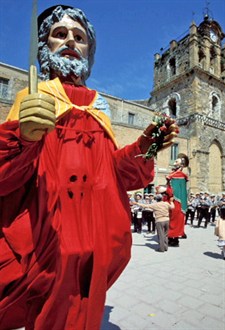The Giants in the Renaissance and Baroque period
 Between the end of the sixteenth and the eighteenth century something happened which was decisive for the future of European giants: their final exit from the religious scenography in which they were placed (the processions of Corpus Domini) and the beginning of a continuous history of contamination due to the introduction of profane elements drawn from classical cosmologies (which enhance the profiles of Hercules, Cronus and the other Olympian gods) and national and local legends. Just to give an example, many of the giants began representing the Philistine giant Goliath, which, while maintaining their original appearance, assumed the identity of local mythical heroes or became anonymous. One of the main novelties compared to traditional themes was represented by the proliferation around a puppet founder of a family of giants (consisting of a wife and one or more children). This transformation allowed the public to associate the old giants a new identity and the latter to survive to the present day thanks to their ability to adapt.
Between the end of the sixteenth and the eighteenth century something happened which was decisive for the future of European giants: their final exit from the religious scenography in which they were placed (the processions of Corpus Domini) and the beginning of a continuous history of contamination due to the introduction of profane elements drawn from classical cosmologies (which enhance the profiles of Hercules, Cronus and the other Olympian gods) and national and local legends. Just to give an example, many of the giants began representing the Philistine giant Goliath, which, while maintaining their original appearance, assumed the identity of local mythical heroes or became anonymous. One of the main novelties compared to traditional themes was represented by the proliferation around a puppet founder of a family of giants (consisting of a wife and one or more children). This transformation allowed the public to associate the old giants a new identity and the latter to survive to the present day thanks to their ability to adapt.
